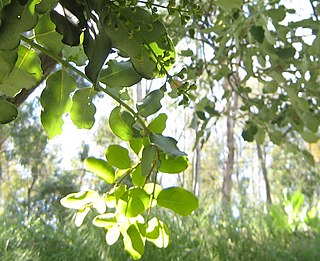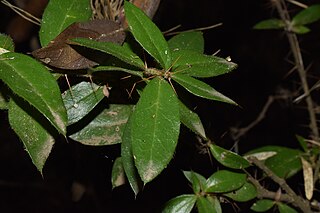
Araucaria araucana, commonly called the monkey puzzle tree, monkey tail tree, piñonero, pewen or Chilean pine, is an evergreen tree growing to a trunk diameter of 1–1.5 m (3.3–4.9 ft) and a height of 30–40 m (98–131 ft). It is native to central and southern Chile and western Argentina. It is the hardiest species in the conifer genus Araucaria. Because of the prevalence of similar species in ancient prehistory, it is sometimes called a living fossil. It is also the national tree of Chile. Its conservation status was changed to Endangered by the IUCN in 2013 due to the dwindling population caused by logging, forest fires, and grazing.

The Maule Region is one of Chile's 16 first order administrative divisions. Its capital is Talca. The region derives its name from the Maule River which, running westward from the Andes, bisects the region and spans a basin of about 20,600 km2. The Maule river is of considerable historic interest because, among other reasons, it marked the southern limits of the Inca Empire.

Quillaja saponaria, the soap bark tree or soapbark, is an evergreen tree in the family Quillajaceae, native to warm temperate central Chile. In Chile it occurs from 32 to 40° South Latitude approximately and at up to 2000 m (6500 ft) above sea level. It can grow to 15–20 m (50–65 ft) in height. The tree has thick, dark bark; smooth, leathery, shiny, oval evergreen leaves 3–5 cm long; white star-shaped flowers 15 mm diameter borne in dense corymbs; and a dry fruit with five follicles each containing 10–20 seeds. The tree has several practical and commercial uses.

Nothofagus dombeyi, Dombey's beech, coigue, coihue or coigüe is a tree species native to southern Chile and the Andean parts of Argentine Patagonia. It is a fast-growing species that can live in a wide range of climatic conditions, and forms dense forests. It is cultivated for its timber, and as an ornamental subject.

Ugni molinae, commonly known as Chilean guava berry, or strawberry myrtle, is a shrub native to Chile and adjacent regions of southern Argentina. The local Spanish name is murta, and the Mapuche Native American name is "uñi". It is in the same botanical family as the guava, in Myrtaceae.

Jubaea is a genus of palms with one species, Jubaea chilensis, commonly known in English as the Chilean wine palm or Chile cocopalm, and palma chilena in Spanish. It is native to southwestern South America and is endemic to a small area of central Chile between 32°S and 35°S in southern Coquimbo, Valparaíso, Santiago, O'Higgins, and northern Maule regions.

La Campana National Park is in the Cordillera de la Costa, Quillota Province, in the Valparaíso Region of Chile. La Campana National Park and the Vizcachas Mountains lie northwest of Santiago. This national park covers approximately 80 square kilometres (31 sq mi) and is home to one of the last palm forests of Jubaea chilensis, which prehistorically had a much wider distribution than at present. Another attraction is the Cerro La Campana, which lends its name to the park. In 1834 Charles Darwin climbed this mountain, during the second voyage of HMS Beagle.

Gunnera tinctoria, known as giant rhubarb, Chilean rhubarb, or nalca, is a flowering plant species native to southern Chile and neighboring zones in Argentina. It is unrelated to rhubarb, as the two plants belong to different orders, but looks similar from a distance and has similar culinary uses. It is a large-leaved perennial plant that grows to more than two metres tall. It has been introduced to many parts of the world as an ornamental plant. In some countries, such as New Zealand, the United Kingdom and Ireland, it has spread from gardens and is becoming an introduced species of concern. It is known under the synonyms: Gunnera chilensis Lam. and Gunnera scabra Ruiz & Pav.

Vachellia caven is an ornamental tree in the family Fabaceae. Vachellia caven is native to Argentina, Bolivia, Chile, Paraguay, Uruguay and Rio Grande do Sul in Brazil. It grows four to five metres tall and bears very stiff and sharp white thorns up to 2 cm in length. It blooms in spring, with bright yellow flower clusters 1–2 cm (0.39–0.79 in) in diameter.

Maytenus magellanica is a small evergreen tree from the genus Maytenus, up to 5 meters (16 ft), in the Celastraceae. It grows in southern Argentina and Chile from 36ºS to Cape Horn (56ºS).

Maytenus boaria (mayten) is an evergreen tree of the family Celastraceae, native from South America, up to 20 m (66 ft), 80 cm (31 in) diameter, straight trunk. It occurs naturally approximately from 30 to 50°S: Chile.

Nothofagus alpina, also called rauli or raulí beech is a species of plant in the Nothofagaceae family. A deciduous tree, it grows in Chile and Argentina, it reaches 50 m (160 ft) height and more than 2 meters (6.5 feet) in diameter. Its distribution goes from 35 to 42° South latitude. It is found on the Andes. It tolerates low temperatures and heavy winds. It has a straight and cylindrical trunk with grey bark. N. alpina was proposed to be renamed Lophozonia alpina in 2013.

Cryptocarya alba, the peumo or Chilean acorn, is an evergreen tree that grows in Chile and Argentina from 33 to 40° southern latitude. It can live both in wet and as in dry conditions. Its distribution can reach up to 1500 meters (5000 ft) above sea level. It measures up to 20 meters (65 ft) height and one meter diameter, with cracked gray bark. An associate tree is the endangered Chilean Wine Palm, Jubaea chilensis, which species prehistorically had a much wider range.

Beilschmiedia berteroana is a threatened evergreen tree in the family Lauraceae endemic to Chile at 35 to 37°S.

Beilschmiedia miersii, commonly known as the northern acorn tree, is a species of evergreen tree in the family Lauraceae. It is native to central Chile from 30 to 35°S., up to 1200 meters (4000 ft) above sea level and lives under very dry conditions.

Weinmannia trichosperma, the tineo, is an evergreen tree in the family of Cunoniaceae, it is native to Chile and Argentina: 35 to 47°S. endemic to laurel forest habitat.

Gevuina avellana is an evergreen tree, up to 20 meters tall. It is the only species currently classified in the genus Gevuina. It is native to southern Chile and adjacent valleys in Argentina. It is found from sea level to 700 meters above sea level. Its distribution extends from 35° to 44° south latitude. The composite leaves are bright green and toothed, and the tree is in flower between July and November. The flowers are very small and beige to whitish, are bisexual and group two by two in long racemes. The fruit is a dark red nut when young and turns black. The peel is woody. It can grow up straight or branched from the soil, making up either a tree or a shrub.

Kageneckia oblonga is a species of plant in the family Rosaceae. It is endemic to Chile. K. oblonga is an evergreen tree. It grows from Coquimbo to Malleco. Example occurrences are found specifically found in central Chile within the La Campana National Park and Cerro La Campana forest areas. In these areas the endangered Chilean Wine Palm, Jubaea chilensis is an associated tree species.

Dasyphyllum excelsum is a species of flowering plant in the family Asteraceae. This species is endemic to Chile, occurring from Quillota to Cauquenes between 190 and 800 m above sea level, a specific location of occurrence being in central Chile within the Cerro La Campana forests in association with the endangered Chilean wine palm, Jubaea chilensis.

Crinodendron hookerianum, known as the Chilean lantern tree, is an evergreen tree in the family Elaeocarpaceae. It is endemic to Chile, where it occurs from Cautin to Palena. It grows near streams and in very humid and shady places, and is often found in Valdivian temperate forests.




















